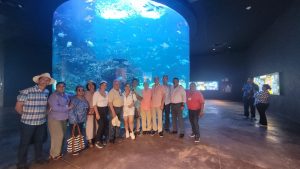 -Editorial
-Editorial
Mazatlán, Sinaloa — The Federación de Asociaciones de Periodistas Mexicanos (Fapermex) held its latest National Council session in Mazatlán, bringing together journalists from across the country for a dynamic exchange of ideas, reflection on the profession, and a celebration of the progress the organization has achieved under the leadership of its president, Eva Guerrero, who is preparing to conclude her term.
The gathering, which also included representatives of the Colegio Nacional de Licenciados en Periodismo (Conalipe), combined formal council sessions with field activities aimed at highlighting Mazatlán’s role as a cultural and educational hub. Among the highlights was an organized visit to the Gran Acuario Mazatlán, one of the most ambitious marine education and conservation projects in Latin America.
A Session of Balance and Transition
For Guerrero, who has led Fapermex during a period marked by both challenges and opportunities for Mexican journalism, the Mazatlán meeting represented more than a routine session: it was an opportunity to showcase the values of unity, professionalism, and social responsibility that have guided her administration.
“This council session is a space not only for decision-making but for reaffirming our commitment to journalism as a cornerstone of democracy,” Guerrero emphasized in her opening remarks. She noted that, as her term comes to a close, Fapermex continues to grow in membership, expand its collaborations, and strengthen its stance on defending freedom of expression and the rights of journalists nationwide.
Journalists Experience Mazatlán’s “Living Classroom”
As part of the session, attendees were invited to tour the Gran Acuario Mazatlán, an experience they described as “spectacular.” The facility, located in Mazatlán’s Central Park, has quickly positioned itself as a world-class institution not only for tourism but also for education and scientific research.
Guided by Andrea Toledo Pineda, the aquarium’s Manager of Education for Conservation, the visiting journalists explored its modern exhibits, learning how the aquarium functions as a “living classroom” where theory is transformed into hands-on, interactive learning.
“To see turtles, sharks, and countless species so closely, and to observe the work of biologists and chemists, is a lesson in itself,” said one participant. The group highlighted how the aquarium inspires young people to consider careers in science, conservation, and marine biology, offering them real role models who dedicate their lives to protecting the Sea of Cortez and its ecosystems.
Educational Innovation on Display
The visit underscored how the Gran Acuario has aligned itself with the principles of the New Mexican School, serving as a partner to educators at all levels, from preschool through postgraduate. Students who visit can experience science through direct contact with marine species, transforming abstract knowledge into lived experience.
Toledo Pineda explained that this approach is not only about entertainment but about instilling values of conservation and sustainability: “When children see these animals in their environment, when they touch, feel, and learn directly, they develop a deeper respect for nature.”
Journalists praised the facility for its dual role as both an attraction for visitors and a platform for environmental awareness that resonates far beyond Sinaloa. The Oceanic Research Center of the Sea of Cortez (CIOMC), which operates in partnership with the aquarium, adds another layer by advancing high-level research and sharing its findings with the public.
Strengthening Professional Bonds
The council sessions themselves focused on reviewing the year’s activities, preparing proposals for future initiatives, and discussing the ongoing challenges faced by journalists in Mexico, from threats to press freedom to the need for continued professional training.
Participants noted that the venue in Mazatlán, with its blend of tradition, natural beauty, and innovation, provided an ideal setting for reflecting on the responsibilities of the profession and renewing collective commitments.
A Legacy of Leadership
As Eva Guerrero prepares to hand over the presidency of Fapermex, her colleagues recognized her efforts to modernize the organization, foster stronger ties with Conalipe, and promote a vision of journalism deeply connected to society.
“Eva has left a clear mark of integrity and service,” one board member remarked. “She has built bridges between generations of journalists and strengthened the national network that supports us all.”
Ellie Burgueno, Editor-in-Chief of Beyond Borders Gazette, continues to serve on the Fapermex board as Director of Binational Relations, contributing her expertise in cross-border journalism and media relations. Her ongoing involvement will help strengthen collaborations between Mexican and U.S. media, ensuring continued growth in binational initiatives.
The Mazatlán session closed with a renewed sense of purpose. Attendees departed not only with the memory of an enriching visit to one of the most impressive aquariums in Latin America but also with a collective acknowledgment of the importance of journalism in shaping Mexico’s democratic and cultural life.
For Guerrero, it was a fitting stage for the final stretch of her presidency: a session that celebrated knowledge, education, and the social impact of journalism—values that will continue to guide Fapermex in the years ahead.


